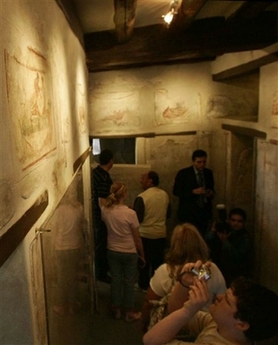Ancient brothel restored in Pompeii
(AP)
Updated: 2006-10-27 07:39
POMPEII, Italy - It was the jewel of Pompeii's libertines: a brothel
decorated with frescoes of erotic figures believed to be the most popular in the
ancient Roman city.
The Lupanare - which derives its name from the Latin word "lupa," or
"prostitute" - was presented to the public again Thursday following a
yearlong, US$253,000 restoration to clean up its frescoes and fix the structure.
|

Erotic frescoes are seen on the wall
of the 'Lupanare', the newly restored brothel which derives its name from
the Latin word 'Lupa' for 'prostitute', in Pompeii, near Naples, Italy,
during the official opening after a one-year restoration of its structure
and decorations, Thursday, Oct. 26, 2006. [AP]
| Pompeii was destroyed in A.D. 79 by a cataclysmic
eruption of Mount Vesuvius that killed thousands of people - and buried the
city in 20 feet of volcanic ash, preserving Pompeii for 1,600 years and
providing precious information on what life was like in the ancient world.
Among the buildings was the two-story brothel with 10 rooms - five on
each floor - and a latrine. Each room on the ground floor bears a fresco of
a different sex scene painted over its door - possibly suggesting the
prostitute's specialty.
The upper floor was for higher-ranking clients. The stone beds were covered
with mattresses and each room has names engraved in its walls - possibly
those of the prostitutes and their clients.
The brothel - once centrally located near the city's forum and the
market - is open to the public as part of the regular tour of the ruins of
Pompeii, east of Naples.
"The legend that Pompeii was a lascivious city is true - and not true,"
said Pietro Giovanni Guzzo, the site's top archaeological official. "There was
ample opportunity for sexual relations, but the prostitute in the technical
sense was confined to one place."
The building was unearthed in 1862 and has undergone several restorations
since, most recently in 1949, officials in Pompeii said. The latest restoration
focused on fixing leaks in the building and restoring the frescoes, which had
turned yellow and had faded in parts.
Libertine habits flourished in Pompeii, and considerable evidence testifies
that the city's wealthy merchants and visiting sailors had a taste for
eroticism.
The prostitutes were slaves and were usually of Greek or other foreign
origin, and they commanded prices up to eight times the cost of a portion of
wine, with revenues going to their owner or the manager of the brothel,
officials said.
|